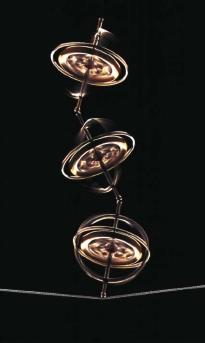I. Introduction
The gyroscope is a spinning wheel on a movable axis or axes. It was invented in 1852 by Jean Bernard Leon Foucault, a French scientist and physicist. Having normal physical properties when stationary, the gyroscope behaves interestingly when the wheel is spun. It is used for navigational purposes and has recently been incorporated into the iPhone.

Figure 1: Three Gyroscopes Balancing On Top of Each Other
II. Invention
To invent the gyroscope, Foucault took a heavy wheel, attached it to a shaft, and spun it very quickly. After experimenting with its properties, he realized that this new invention had many practical uses. For example, navigators or travelers could use a gyroscope to "detect deviations from a straight course" (http://www.madehow.com). Also, the gyroscope could be used to help stabilize machines and monitor motors. Therefore, Foucault created devices related to his gyroscope that effectively monitored engine velocity. These devices were used in big steam engines and telescope clock-drives. For demonstrations on how a gyroscope works and how it is currently used, see the links below.

Figure 2: Gyroscope Model
III. Inventor
Jean Bernard Leon Foucault was born on September 19, 1819, in Paris, France. He had a lot of success working as an experimental physicist. Foucault also shared many of the same scientific beliefs as Galileo. For example, they both believed that "experimentation and innovation were the best ways to accurately assess the properties of the natural world" (http://www.madehow.com). In 1852, Foucault invented the gyroscope, and he also invented the pendulum in 1851. He used the pendulum to prove that the earth rotates on its axis by performing a huge demonstration with a massive pendulum. Furthermore, he was the first man to photograph the surface of the sun, he proved that humans have binocular vision, and he amazingly measured the speed of light by using rotating mirrors in his laboratory. Jean Bernard Leon Foucault died on February 11, 1868, in France.
Figure 3: Jean Bernard Leon Foucault
IV. Impact on the World/Humanity
The gyroscope has had a surprisingly significant impact on the world; it is used on planes and even in iPhones. On airplanes, the gyroscope's position compared to the airplane's position tells the pilot how much the airplane is tilting. This is very valuable information when the pilot needs to make turns, allowing the plane's turns to be accurate and precise. Therefore, the gyroscope plays a vital role in the efficiency and safety of airplane flights. Also, the gyroscope is used to enhance the technology and capabilities of appliances such as the iPhone. Although this is not a necessary addition, it is still fun to play games, like Jenga, that seem even more realistic than before the gyroscope technology was added (see video).
V. Journal Article Review
In my journal article, a group of scientists were studying how to make a 30-gram aircraft that flies indoors and avoids obstacles and maintains altitude independently using technology involving a gyroscope. To start their experiment, they first used their technology on a rolling robot. It was able to move indoors for over forty-five minutes without crashing into any obstacles. Then, the scientists tested the actual 30-gram aircraft. It was able to fly for over four minutes without a collision. Although their design is not perfect, the group of scientists believe their general strategy will one day produce their desired results.
VI. References
Foucault -- 19th Century Physicist. (n.d.). Welcome to LoST ART. Retrieved February 20, 2011, from http://helix.gatech.edu/Classes/ME2202/2000S3/Projects/Swarner/foucault.htm
Gyroscopes - Elmer Sperry and Charles Stark Draper Gyroscopes. (n.d.). Inventors. Retrieved February 20, 2011, from http://inventors.about.com/library/inventors/blgyroscope.htm
Jean-Bernard-Léon Foucault Biography (1819-1868). (n.d.). How Products Are Made. Retrieved February 20, 2011, from http://www.madehow.com/inventorbios/39/Jean-Bernard-L-on-Foucault.html
Practical Management. (n.d.). Retrieved February 20, 2011, from http://www.practicalmanagementllc.com
Science Clarified. (n.d.). Retrieved February 20, 2011, from http://www.scienceclarified.com
YouTube - Gyroscope. (n.d.). YouTube - Broadcast Yourself. Retrieved February 20, 2011, from http://www.youtube.com/watch?v=cquvA_IpEsA
YouTube - iPhone 4's new gyroscope. (n.d.). YouTube - Broadcast Yourself. Retrieved February 20, 2011, from http://www.youtube.com/watch?v=ORcu-c-qnjg
Zufferey, J., & Floreano, D. (n.d.). Toward 30-gram Autonomous Indoor Aircraft: Vision-based Obstacle Avoidance and Altitude Control.



No comments:
Post a Comment